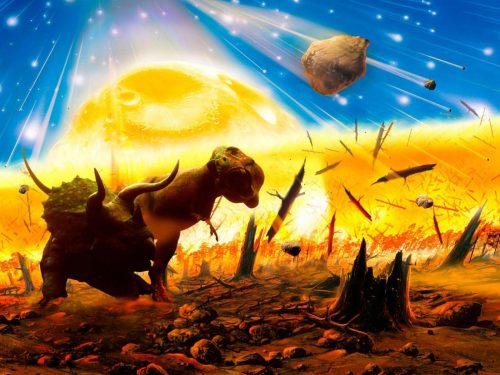Image courtesy of Peter Arnold, Inc., National Geographic.
Geologists have long debated the primary driver of the mass extinction which occurred more than sixty-six million years ago. Until recently, the discussion had consistently bounced between two dominant hypotheses: extraterrestrial impacts or severe volcanic activity in the Deccan Province of India. New research has presented a solid empirical case for the former—the massive asteroid impact—as the definitive key motivator for this fifth and most recent extinction event.
Doubt has remained for some time as to the precise “mechanism” for mass ecosystem extinction. “This debate over the driver of this K-Pg mass extinction is long-running and contentious, and a lot of it focuses on the timing of the events relative to the extinction,” said Sophie Westacott, Yale PhD candidate for Geology and Geophysics. Scientists had agreed that a massive meteorite made impact approximately 66.04 million years ago at the Cretaceous-Paleogene (known as K-Pg) boundary, as identified through a geological record in crust and rock. The site is located under Mexico’s Yucatán Peninsula near the town of Chicxulub and has been identified as the crater that killed off all of the dinosaurs (except the birds) and 76 percent of all species on Earth. According to the study, the geological record holds signs of the crater’s impact, including large tsunamis, earthquake-driven gravity flows, and molten ejecta fallout, all of which would have contributed to that terrestrial extinction. Still, it was previously unknown what precise effect this impact had on marine life. Scientists had found it plausible that oceanic organisms had already been dying off prior to the Chicxulub impact event due to increased volcanism in the presence of the Deccan volcanic traps.
Published last October in the Proceedings of the National Academy of the Sciences, the groundbreaking study was co-authored by 14 researchers from institutions around the United States—six with Yale affiliations—and Europe. This collaboration allowed the researchers to pool resources and technologies and ultimately undertake a suite of innovative isotope and Earth system modeling methodologies. “The paper uses empirical records from geochemical proxies alongside computer models of the carbon cycle to help piece together the cause of the mass extinction at the end of the Cretaceous,” said Sofia Menemenlis (YC ’20), a major in Geology and Geophysics. This combination of methods helped the researchers empirically confirm and model the extinction scenario and marine life recovery post-extinction.
The timing of ocean acidification processes, explored through geochemistry, is key to understanding the extent of the effect that the Chicxulub crater and underlying volcanism had in causing the fifth extinction. The researchers’ first method, referred to scientifically as a boron isotopic-pH proxy, was used on oceanic foraminifera preserved at the K-Pg boundary to understand the response of the marine world to the impact event. “Boron isotopes are proxies that can tell us about the pH at the ocean’s surface, which becomes more acidic as atmospheric carbon dioxide increases,” Menemenlis said. The study measured boron preserved in the marine creatures. After analyzing the samples in a variety of temporal and geographical spaces, the researchers did not find signs of ocean acidification until post-impact. Instead, their results show that the ocean’s pH was primarily “stable” at the end of the Cretaceous period and therefore likely unaffected by volcanism. They suggest a rapid acidification that led to near-immediate marine extinction directly after the Chicxulub asteroid impact at the K-Pg. The GENIE, or Grid Enable Earth System, model was used to visualize other changes of the carbon cycle on pH levels. “The evidence for impact has piled up in recent years, and there has been quite a bit that has come out over the last few months—in fact, Science named the collected evidence as one of its ‘breakthroughs of the year,’ calling it a ‘super-year’ for K-Pg work,” Westacott said. Together, this recent research has unearthed a concrete truth explaining the last extinction event this world has seen, sixty-six million years later. The findings raise important questions about today’s acidifying oceans and how marine life will manage in a sixth anthropogenic extinction.
Sources:
https://www.pnas.org/content/116/45/22500
https://people.earth.yale.edu/personnel/leanne-elder-0
https://en.wikipedia.org/wiki/Cretaceous–Paleogene_boundary
https://en.wikipedia.org/wiki/Chicxulub_crater
https://www.eurekalert.org/pub_releases/2019-10/ggph-irw101819.php
https://www.sciencealert.com/here-s-how-biodiversity-experts-recognise-that-we-re-midst-a-mass-extinction
https://www.nytimes.com/2019/10/21/science/chicxulub-asteroid-ocean-acid.html?smid=fb-nytimes&smtyp=cur&fbclid=IwAR2K0IVyUhKZtMBWOIs9nYsa3ns6Pht47wa1PKho4IdHNCN-FiQEa4TNJzM
https://www.theguardian.com/environment/2019/oct/21/ocean-acidification-can-cause-mass-extinctions-fossils-reveal?fbclid=IwAR1gS5Sj_revPYkDB1RAaj-r81vxZtT_QsCVeAXN6VQ60ePHLa8u0x1Lte8
https://vis.sciencemag.org/breakthrough2019/finalists/#A-killer

